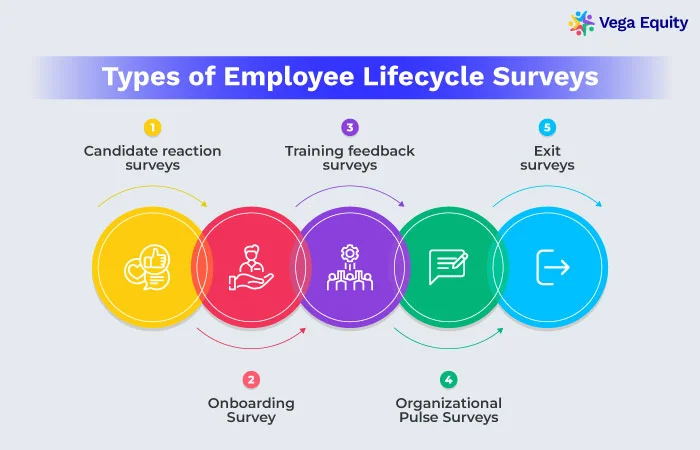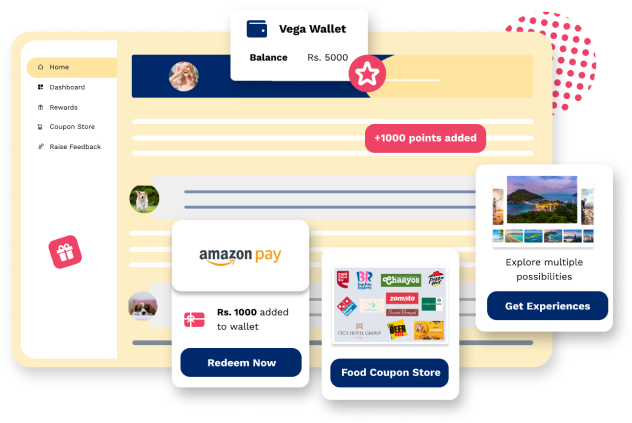Is your company experiencing an increase in employee turnover? Are newly hired employees finding it difficult to adjust and become productive? Do you notice that some of your top performers are leaving the company around their third year of employment?
Understanding the emotions and experiences of individuals at various stages of their employment journey is crucial, from the time they are hired until they leave the company. It's necessary to not only acknowledge the strengths of your current practices but also identify areas that require improvement as a business entity.
These issues, along with many others, can be proactively addressed and mitigated through the use of employee lifecycle surveys.
By proactively seeking feedback at critical points, organizations can address concerns and execute significant improvements to create a positive work atmosphere.
Employee lifecycle surveys serve as a crucial component in your overall employee listening strategy. Employee sentiments towards the organization may vary as time goes on. By surveying employees at specific points in their employment, you can gather targeted data that will help you understand the underlying reasons behind employee feedback . This data can then be used to make informed decisions and take appropriate actions to improve the employee experience.
Let’s understand what an employee lifecycle survey is and how it is crucial for an organization.
What are Employee Lifecycle Surveys?
Organizations leverage Employee Lifecycle Surveys strategically to gather employee feedback at different stages of their employment. These surveys are essential in helping organizations understand and optimize the employee experience, from recruitment to offboarding. The primary objective is to collect valuable insights that can increase employee engagement, satisfaction, and retention.
Understanding the need for employee lifecycle surveys is essential before diving into the benefits and the various types that exist.
Why do we need to use employee lifecycle surveys?
Lifecycle surveys can be utilized by organizations to gain knowledge about the employee experience at various stages of their employment. These surveys provide crucial listening data, enabling both preventive and responsive measures to handle employee concerns. Moreover, lifecycle surveys can offer concrete insights to improve areas where the employee experience may be deficient.
An exit survey strategy could be developed by you if you observe a rise in employee turnover. The information gathered from these exit surveys can assist you in recognizing and dealing with turnover patterns.
By conducting lifecycle surveys, you can gather listening data to assist in answering organizational questions related to:
- The alignment of employees' roles with their skills, understanding of their duties, and expectations
- The effectiveness of managers and team dynamics during the onboarding process
- The level of job satisfaction among employees and their likelihood to recommend the organization to others
- Employee suggestions for improvement
- The reasons why employees choose to join and leave the organization.
Benefits of Employee Lifecycle Surveys
Improved Recruitment
These surveys can significantly assist in optimizing the recruitment process by revealing any potential weaknesses in the hiring procedure through the collection of feedback from job applicants and new employees. This information can then be used to streamline recruitment initiatives, leading to an enhanced candidate experience and a more attractive employer image. To illustrate, should survey data consistently emphasize the significance of screening methods and employer branding, the organization should prioritize these areas in their recruitment process.
Increased Engagement
Through consistently conducting surveys, it is evident that the organization places a high importance on employee opinions and strives to enhance the work environment. This approach results in employees feeling empowered and included, thereby increasing their engagement with the organization.
Employees who believe their voices are heard and their contributions are appreciated are more likely to be devoted and enthusiastic in their work, leading to increased productivity.
Are You Ready to Supercharge Your Employee Engagement Initiatives?
Explore Vega HRs Comprehensive Suite of Employee Engagement Solutions Designed to Transform Your Workplace to Ensure Success.
Enhanced Onboarding
Conducting employee lifecycle surveys can help organizations determine where to enhance the onboarding process by revealing any difficulties or areas where new hires might not feel adequately supported. Gathering input from new employees early on enables companies to make necessary modifications to the onboarding process, promoting a more seamless experience for new hires.
Reduced Turnover
Undoubtedly, employee surveys, specifically exit interviews, offer significant advantages in understanding why workers depart from a company.
These surveys assist organizations in recognizing the elements that lead to employee dissatisfaction, enabling them to take preventive actions and minimize turnover rates.
For example, if a survey indicates that many employees exit the company due to insufficient career development opportunities, the organization can institute mentorship programs or training initiatives to foster employee growth and development.
Therefore, it is crucial for companies to utilize employee surveys to gain insights and make informed decisions that can improve employee satisfaction and reduce turnover.
Stronger Employer Brand
Gathering positive feedback as well as negative feedback from current employees via surveys can provide compelling endorsements for potential candidates, as it showcases a strong employer brand dedicated to employee satisfaction and well-being. This, in turn, can help attract top-tier talent and distinguish the organization from its competitors.
Types of Employee Lifecycle Surveys

1. Candidate reaction surveys
During the recruitment stage, candidate surveys are administered to assess the effectiveness of a company's hiring process for new employees. The survey questions delve into various aspects of their application and recruitment experience. These questions may cover topics such as:
- What led you to discover the job opening?
- How would you rate the professionalism of your recruiter?
- How clear were the explanations provided throughout the process?
- What was the response time like during our communication?
- How satisfied were you with our overall recruiting process?
Given the intense competition for top talent, candidate reaction surveys can uncover valuable insights into the success of a company's outreach to potential candidates, including the impact of advertising and marketing strategies, corporate reputation, employer brand, and recruitment processes.
2. Onboarding Survey
Getting a new employee up to speed and productivity is the primary goal of the onboarding stage.
The ideal onboarding process, also known as 'ramp time,' involves introducing new hires to their colleagues, clarifying their role and expectations, providing access to necessary resources, and instilling the company culture.It is crucial to gather feedback from new employees through onboarding surveys to understand their thoughts and opinions.
The onboarding experience sets the tone for an employee's entire tenure with the company. Some examples of questions that can be included in onboarding surveys are:
- What department do you work in?
- Did you receive all the necessary information before your first day of work?
- Was the information provided during onboarding sufficient?
- Did you find the onboarding process too lengthy, too brief, or just right?
- Were you provided with the necessary equipment on your first day?
Since the onboarding experience is closely tied to key employee experience and engagement metrics, including retention rates, ramp time, and company advocacy, onboarding surveys offer valuable insights.
3. Training feedback surveys
Not only will these be integrated into the onboarding process for new hires undergoing training, but they will also serve as valuable touchpoints during the employment and retention stages, as employees continue to learn and develop. By collecting data after each training event throughout the employee lifecycle, the organization can track individual growth and identify areas where learning and development can be improved. Some sample questions to consider include:
- How relevant did you find the training material to your job role?
- How clearly was the information presented to you?
- How engaging did you find your trainer to be?
- How knowledgeable did your trainer seem on the subject matter?
- How much do you feel you learned from the training event?
4. Organizational Pulse Surveys
It is often necessary to further examine the results of your annual anchor survey. Organizational pulse surveys are specialized surveys that aim to measure a particular theme, department, or aspect of your organization. You also have the option to create your own questions or collaborate with one of our skilled consultants to design the most effective approach for your needs.
Top Survey Incentive Ideas for Survey Participation
This blog sheds light on the importance of survey incentives ideas and provides expert insights that can elevate your employee engagement surveys.
5. Exit surveys
A departing employee's goodbye is an opportunity that should not be simply waved away. Instead, it's crucial to uncover the reasons behind their departure. Conducting exit surveys can provide valuable insights, including:
- The underlying reasons for their decision to leave
- Constructive feedback about their role, management, team, and organization
- Whether they would still be willing to promote your organization in a positive light
Designing an effective employee lifecycle survey is beneficial for creating a robust organization, so let’s go through some of the suggestions in detail regarding it and how it can be implemented.
How to design an employee lifecycle survey?
Surveys that assess the employee experience at various stages of their employment, also known as employee lifecycle surveys, are essential for gaining insight into the employee experience. When creating these surveys, keep the following points in mind:
1. Identify Lifecycle Stages:
The most common lifecycle stages to survey are:
- Recruitment/Candidate Experience
- Onboarding
- Ongoing Employment (e.g. engagement, training, performance)
- Exit/Offboarding
2. Use Targeted Question Types:
Leverage a mix of question types to gather both quantitative and qualitative feedback:
- Multiple choice
- Rating scales
- Open-ended questions
3. Connect Data across Surveys:
Integrating survey data across the employee lifecycle is crucial for gaining a comprehensive understanding of the employee experience. By using a single platform, standardized templates, and data visualization tools, organizations can uncover trends, identify areas for improvement, and make data-driven decisions to enhance employee satisfaction and retention , overall organizational performance.
4. Communicate the importance of your Surveys:
With your surveys designed and built, the next step is to internally promote their value across the organization.Unlike other survey types, lifecycle surveys constantly run in the background and require regular communication.
Begin by informing your organization about the significance of lifecycle surveys, highlighting the types of questions to be asked and illustrating how the resulting data can instigate positive change.
Conclusion
Employee lifecycle surveys are a valuable resource for measuring employee feelings at different points of their employment. Through the creation of well-planned surveys and analysis of the resulting data, companies can enhance their recruitment, onboarding, training, and overall employee experience. This can ultimately result in increased employee engagement , satisfaction, and retention.
About Vega HR
Vega-HR is a powerful tool in the talent war, offering employee rewards, recognition, and pulse recognition. With an engaging platform, it fosters a world-class work culture, providing P2P recognition, social feedback, on-spot recognition, and monetizable incentive solutions with 3000+ coupons in various categories.
Create a Culture People Want to Stick to
- Send rewards
- Give shoutouts
- Build a community
- Gift experiences
Get a demo
 Written by Hrithik Das 05 August 2024 | 4 min read
Written by Hrithik Das 05 August 2024 | 4 min read





